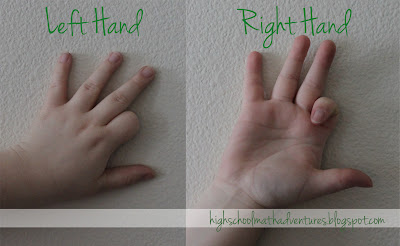Note: This trick was designed only to help remember the first quadrant of the unit circle but I will show you my own little trick to applying it to all of the unit circle.
For this 'trick' to be most effective students should use their glove hand (you know, the hand your glove goes on in baseball/softball; the left for those who are right-handed, and the right for those who are left-handed). The below pictures shows how to hold your hands.
Each one of your five fingers represents a special points on the Unit Circle:
Thumb - 0° or 0π (2π)
Index Finger - 30° or π/6
Middle Finger - 45° or π/4
Ring Finger - 60° or π/3
Pinky Finger - 90° or π/2
Finding Sine and Cosine: First Quadrant
When finding sine and cosine remember your answer always looks like the square root of something over two (√?/2).Step one: To find the value for sine/cosine just fold down the respective finger. For example, if we wanted to find sine/cosine values for 30° or π/6 we would fold down the index finger.
Step two: Now we turn our hands into an ordered pair; parentheses on the outside and a comma where the folded down finger is.
So continuing with our example of 30° or π/6 we get (3,1).
Step three: We must now implement what was stated before step one (√?/2), which gives us (√3/2, √1/). This simplifies to (√3/2, 1/2).
Step four: Since we know on the unit circle, the ordered pairs are presented (cosine, sine) we can conclude that the sin(30°) or sin(π/6) is equal to 1/2 and the cos(30°) or cos(π/6) is equal to √3/2.
Note: This does work for 0° and 90°. 0/2=0 and √4/2=2/2=1.
Finding Sine and Cosine: Second Quadrant
This is almost as easy as the process for Quadrant I, but with a few small changes. First things, first, we need to flip our hands (just like a reflection over the y-axis). Now each finger represents a new point on the unit circle:Pinky Finger: 90° or π/2
Ring Finger: 120° or 2π/3
Middle Finger: 135° or 3π/4
Index Finger: 150° or 5π/6
Thumb: 180° or π
Now we follow steps one through three for Finding Sine and Cosine: First Quadrant.
For example, if we were trying to find the sine/cosine values of 120° or 2π/3 we would get (√3/2, 1/2).
Step four: Since we flipped our hands over the y-axis, we now must switch our values in our ordered pair.
Thus we now have (1/2, √3/2).
Step Five: Finally we must apply negative signs where appropriate for the second quadrant (the x-value of the order pair).
Therefore we end up with (-1/2, √3/2) and can conclude that sin(120°) or sin(2π/3) is equal to -1/2 and cos(120°) or cos(2π/3) is equal to √3/2.
Finding Sine and Cosine: Third Quadrant
This is exactly the same as Finding Sine and Cosine: Second Quadrant, except for step five, we now negate both value of the ordered pair. (You also have to reflective your hand again, this time over the x-axis. Or starting from the original position, rotate 180° counter clockwise. This is an awkward position for the right handed people. Fingers will also now represent new positions on the unit circle.)Finding Sine and Cosine: Fourth Quadrant
Starting from the original position, flip your hand down (reflect over the x-axis). Fingers will also now represent new positions on the unit circle. (This is an awkward position for the left handed people)Follow steps one through three for Finding Sine and Cosine: First Quadrant.
Step four: Apply negative signs where appropriate for the fourth quadrant (the y-value of the order pair).
Finding Tangent:
Follow step one and two for Finding Sine and Cosine: First Quadrant. Going back to our example of 30° or π/6 we get (3,1).Step three: Rotate your ordered pair 90° counter clockwise and turn into a fraction.
Step four: Place fraction under radical sign and simplify.
Step five: Now we can conclude that tan(30°) or tan(π/6) is equal to √3/3.
Congratulations if you made it to the bottom of this post. I hope that this all made sense to you. If not, please ask questions, I'm more than happy to help you understand.
If you use this in your classroom, please leave a comment below; I am curious as to how your students will react.








Oh my goodness, you have no idea how helpful this is! I have been struggling this whole year with figuring out how to get through the unit circle quickly and this is exactly what I have been looking for. This will help on my final immensely. Thank you! You will be a GREAT math teacher!! :)
ReplyDeleteThis blog post is truly enormous; the standard things of the post are fully incredible. class rings
ReplyDeletexcept for step five, we now negate both value of the ordered pair. moissanite
ReplyDeleteSuch a helpful resource!
ReplyDeleteWow! This is absolutely brilliant and tremendously helpful! Thank you so much for sharing ~����
ReplyDeletegood idea thanks a lot
ReplyDeleteTrigonometric ratios, fast app to find: sine, cosine, tangent, cotangent, secant and consecante of an angle
ReplyDeletehttps://play.google.com/store/apps/details?id=com.anazco.juan.razonestrigonometricas&hl=en
Such a great post. I regret that why I did not find this in my student life as I had to struggle a lot to remember this. But I think its not too late , as I can easily run my class with pleasure using your tricks and my students will get them really effective.
ReplyDeleteGrand Circus Casino - Mapyro
ReplyDeleteGrand Circus Casino. 대전광역 출장안마 Grand Circus Casino features 1280 slot 대전광역 출장샵 machines, a poker room, and a bar. 전주 출장샵 Each 청주 출장마사지 room has 5 table games. You can play 구미 출장마사지 Blackjack, Roulette,